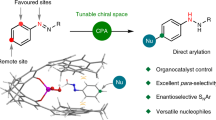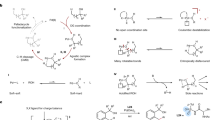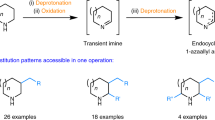Abstract
New synthetic methods for the catalytic functionalization of C–H bonds have the potential to revolutionize the synthesis of complex molecules1,2,3,4. However, the realization of this synthetic potential requires the ability to functionalize selectively one C–H bond in a compound containing many such bonds and an array of functional groups. The site-selective functionalization of aliphatic C–H bonds is one of the greatest challenges that must be met for C–H bond functionalization to be used widely in complex-molecule synthesis1,3,5,6, and processes catalysed by transition-metals provide the opportunity to control selectivity7,8. Current methods for catalytic, aliphatic C–H bond functionalization typically rely on the presence of one inherently reactive C–H bond9,10, or on installation and subsequent removal of directing groups that are not components of the desired molecule8. To overcome these limitations, we sought catalysts and reagents that would facilitate aliphatic C–H bond functionalization at a single site, with chemoselectivity derived from the properties of the catalyst and site-selectivity directed by common functional groups11 contained in both the reactant and the desired product. Here we show that the combination of an iridium-phenanthroline catalyst and a dihydridosilane reagent leads to the site-selective γ-functionalization of primary C–H bonds controlled by a hydroxyl group, the most common functional group in natural products12. The scope of the reaction encompasses alcohols and ketones bearing many substitution patterns and auxiliary functional groups; this broad scope suggests that this methodology will be suitable for the site-selective and diastereoselective functionalization of complex natural products.
This is a preview of subscription content, access via your institution
Access options
Subscribe to this journal
Receive 51 print issues and online access
$199.00 per year
only $3.90 per issue
Buy this article
- Purchase on Springer Link
- Instant access to full article PDF
Prices may be subject to local taxes which are calculated during checkout



Similar content being viewed by others
References
Gutekunst, W. R. & Baran, P. S. C–H functionalization logic in total synthesis. Chem. Soc. Rev. 40, 1976–1991 (2011)
McMurray, L., O'Hara, F. & Gaunt, M. J. Recent developments in natural product synthesis using metal-catalysed C–H bond functionalisation. Chem. Soc. Rev. 40, 1885–1898 (2011)
Chen, K. & Baran, P. S. Total synthesis of eudesmane terpenes by site-selective C–H oxidations. Nature 459, 824–828 (2009)
Godula, K. & Sames, D. C–H bond functionalization in complex organic synthesis. Science 312, 67–72 (2006)
Feng, Y. & Chen, G. Total synthesis of celogentin C by stereoselective C–H activation. Angew. Chem. Int. Ed. 49, 958–961 (2010)
Giannis, A., Heretsch, P., Sarli, V. & Stößel, A. Synthesis of cyclopamine using a biomimetic and diastereoselective approach. Angew. Chem. Int. Ed. 48, 7911–7914 (2009)
Yu, J.-Q. & Shi, Z. in Topics in Current Chemistry Vol. 292 (Springer, 2010)
Lyons, T. W. & Sanford, M. S. Palladium-catalyzed ligand-directed C−H functionalization reactions. Chem. Rev. 110, 1147–1169 (2010)
Chen, M. S. & White, M. C. A predictably selective aliphatic C–H oxidation reaction for complex molecule synthesis. Science 318, 783–787 (2007)
Newhouse, T. & Baran, P. S. If C–H bonds could talk: selective C–H bond oxidation. Angew. Chem. Int. Ed. 50, 3362–3374 (2011)
Lu, Y., Wang, D.-H., Engle, K. M. & Yu, J.-Q. Pd(II)-catalyzed hydroxyl-directed C–H olefination enabled by monoprotected amino acid ligands. J. Am. Chem. Soc. 132, 5916–5921 (2010)
Henkel, T., Brunne, R. M., Müller, H. & Reichel, F. Statistical investigation into the structural complementarity of natural products and synthetic compounds. Angew. Chem. Int. Ed. 38, 643–647 (1999)
Simmons, E. M. & Hartwig, J. F. Iridium-catalyzed arene ortho-silylation by formal hydroxyl-directed C−H activation. J. Am. Chem. Soc. 132, 17092–17095 (2010)
Boebel, T. A. & Hartwig, J. F. Silyl-directed, iridium-catalyzed ortho-borylation of arenes. A one-pot ortho-borylation of phenols, arylamines, and alkylarenes. J. Am. Chem. Soc. 130, 7534–7535 (2008)
Mkhalid, I. A. I., Barnard, J. H., Marder, T. B., Murphy, J. M. & Hartwig, J. F. C–H activation for the construction of C–B bonds. Chem. Rev. 110, 890–931 (2010)
Crotti, C. et al. Evaluation of the donor ability of phenanthrolines in iridium complexes by means of synchrotron radiation photoemission spectroscopy and DFT calculations. Dalton Trans. 133–142 (2007)
Corriu, R. J. P. & Moreau, J. J. E. Selective catalytic route to bifunctional silanes. Catalysis by rhodium and ruthenium complexes of the alcoholysis of diarylsilanes and the hydrosilylation of carbonyl compounds. J. Chem. Soc. Chem. Commun. 38–39 (1973)
Bosworth, N. & Magnus, P. D. Studies on terpenes. Part I. Rearrangement of 7-oxatricyclo[4,3,0,0]nonanes into 8-substituted 1,3,3-trimethylnorbornane derivatives. J. Chem. Soc. Perkin Trans. I 943–948 (1972)
Miyazawa, M. & Miyamoto, Y. Biotransformation of (+)-(1R,2S)-fenchol by the larvae of common cutworm (Spodoptera litura). Tetrahedron 60, 3091–3096 (2004)
Deng, J. G., Jiang, Y. Z., Liu, G. L., Wu, L. J. & Mi, A. Q. A practical method for the synthesis of homochiral 2,10-camphanediols. Synthesis 963–965 (1991)
Plé, K., Chwalek, M. & Voutquenne-Nazabadioko, L. Synthesis of α-hederin, δ-hederin, and related triterpenoid saponins. Eur. J. Org. Chem. 2004, 1588–1603 (2004)
García-Granados, A., López, P. E., Melguizo, E., Parra, A. & Simeó, Y. Remote hydroxylation of methyl groups by regioselective cyclopalladation. Partial synthesis of hyptatic acid-A. J. Org. Chem. 72, 3500–3509 (2007)
Kitagawa, I., Hori, K., Sakagami, M., Zhou, J. L. & Yoshikawa, M. Saponin and sapogenol. XLVIII. On the constituents of the roots of Glycyrrhiza uralensis Fischer from northeastern China. (2). Licorice-saponins D3, E2, F3, G2, H2, J2, and K2. Chem. Pharm. Bull. (Tokyo) 41, 1337–1345 (1993)
Majetich, G. & Wheless, K. Remote intramolecular free radical functionalizations: an update. Tetrahedron 51, 7095–7129 (1995)
Chen, K., Richter, J. M. & Baran, P. S. 1,3-diol synthesis via controlled, radical-mediated C−H functionalization. J. Am. Chem. Soc. 130, 7247–7249 (2008)
Kasuya, S., Kamijo, S. & Inoue, M. Direct construction of 1,3-diaxial diol derivatives by C−H hydroxylation. Org. Lett. 11, 3630–3632 (2009)
Desai, L. V., Hull, K. L. & Sanford, M. S. Palladium-catalyzed oxygenation of unactivated sp3 C−H bonds. J. Am. Chem. Soc. 126, 9542–9543 (2004)
Giri, R. et al. Pd-catalyzed stereoselective oxidation of methyl groups by inexpensive oxidants under mild conditions: a dual role for carboxylic anhydrides in catalytic C−H bond oxidation. Angew. Chem. Int. Ed. 44, 7420–7424 (2005)
Litvinas, N. D., Brodsky, B. H. & Du Bois, J. C−H hydroxylation using a heterocyclic catalyst and aqueous H2O2 . Angew. Chem. Int. Ed. 48, 4513–4516 (2009)
Zalatan, D. N. & Du Bois, J. in Topics in Current Chemistry Vol. 292 (eds Yu, J.-Q. & Shi, Z. ) 347–378 (Springer, 2010)
Acknowledgements
We thank the US National Science Foundation (CHE-0910641 to J.F.H.) and the US National Institutes of Health (GM087901 to E.M.S.) for funding this work, and Johnson Matthey for a gift of [Ir(cod)OMe]2.
Author information
Authors and Affiliations
Contributions
E.M.S. and J.F.H. conceived the work and designed the experiments. E.M.S. performed the experiments. Both authors analysed the data and wrote the manuscript.
Corresponding author
Ethics declarations
Competing interests
The authors declare no competing financial interests.
Supplementary information
Supplementary Information
This file contains Supplementary Materials and Method, Supplementary Experimental Procedures and Spectral Data , 1H and 13 C NMR Spectra and additional references. (PDF 3547 kb)
Rights and permissions
About this article
Cite this article
Simmons, E., Hartwig, J. Catalytic functionalization of unactivated primary C–H bonds directed by an alcohol. Nature 483, 70–73 (2012). https://doi.org/10.1038/nature10785
Received:
Accepted:
Published:
Issue Date:
DOI: https://doi.org/10.1038/nature10785
This article is cited by
-
Strategic application of C–H oxidation in natural product total synthesis
Nature Reviews Chemistry (2023)
-
Total synthesis of nine longiborneol sesquiterpenoids using a functionalized camphor strategy
Nature Chemistry (2022)
-
C–H activation
Nature Reviews Methods Primers (2021)
-
Site-selective C-H hydroxylation of pentacyclic triterpenoids directed by transient chiral pyridine-imino groups
Nature Communications (2020)
-
Reversing conventional site-selectivity in C(sp3)–H bond activation
Nature Chemistry (2019)
Comments
By submitting a comment you agree to abide by our Terms and Community Guidelines. If you find something abusive or that does not comply with our terms or guidelines please flag it as inappropriate.



